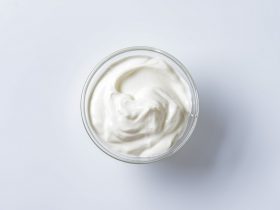Breast milk is the best for babies. Exclusive breastfeeding has been recommended for the first 6 months of a newborn’s life. Breastfeeding should also be continued up to an infant’s first birthday and even beyond (ACOG, 2021).
Women may opt to take multivitamin supplements, such as those containing iodine, iron and vitamin D, while they are breastfeeding. It is important that lactating mothers maintain their own nutrient stores while also providing adequate nutrition to their infants through their breast milk. However, there is little scientific data as to the specific vitamins and amounts that are needed particularly during breastfeeding.
In this article, we will find out more about the benefits of breastfeeding both to the mother and the infant. Nutritional recommendations for lactating mothers will be discussed next. Following are some published data about vitamin recommendations for breastfeeding women. Lastly, effects on breast milk composition with maternal intake of vitamin supplements will be explained.
Benefits of Breastfeeding
Breastfeeding is the most optimal way of feeding newborns because it provides all of the necessary nutrients for their proper growth and development (Martin-Iglesias et al., 2018). For most babies, breast milk is considered the best source of nutrition (CDC, 2020).
Thus, the AAP recommends exclusive breastfeeding for 6 months, “followed by continued breastfeeding as complementary foods are introduced, with continuation of breastfeeding for 1 year or longer as mutually desired by mother and infant” (Section on Breastfeeding, 2012).
Breastfeeding provides immediate, as well as lifelong, benefits for the mother, her infant, the society, economy and environment (Section on Breastfeeding, 2012). It is known that breastfeeding can decrease the risk for certain health conditions for both infants and mothers (CDC, 2020). Moreover, the human breast milk provides unique immunological, nutritional, and evolutionary benefits for every infant, which cannot be provided by formulated cow’s milk (Roostaee et al., 2015).
For Infants
Initiation of breastfeeding within half an hour after a baby’s birth and its continuation as exclusive breastfeeding are considered as major factors in the reduction of infant morbidity and mortality (Roostaee et al., 2015). Other benefits of breastfeeding for infants include decreased risks of the following health conditions (CDC, 2020):
- Asthma
- Obesity
- Type 1 diabetes
- Severe lower respiratory disease
- Acute otitis media
- Sudden infant death syndrome (SIDS)
- Gastrointestinal infections that cause diarrhea and vomiting
- Necrotizing enterocolitis in premature babies
In 2007, Ip et al. concluded in a meta-analysis that breastfeeding was linked to a reduction in the risk of acute otitis media, gastroenteritis, severe lower respiratory tract infections, atopic dermatitis, asthma, obesity, types 1 and 2 diabetes, leukemia, SIDS, and necrotizing enterocolitis in children.
Gibbs & Forste in 2014 revealed that infants who were mainly fed with formula milk for the first 6 months of life had 2.5 times elevated risk of being obese at 24 months of age, compared to those who were exclusively breastfed.
Improvement in social-psychological adjustment was reported by Roostaee et al. (2015) among adolescents from 15 to 18 years old who have been breastfed as babies, with better attachment to their parents and maintenance of close contact with them.
For Mothers
Short term benefits of breastfeeding for mothers include uterine involution, weight loss, and reduced risk of uterine hemorrhage, anemia, hypertension and postpartum depression (Martin-Iglesias et al., 2018). Meanwhile, maternal long term benefits of breastfeeding include reduced chances of developing the following diseases (CDC, 2020):
- Hypertension
- Type 2 diabetes
- Ovarian cancer
- Breast cancer
In 2007, the same study by Ip et al. found that for women, a history of breastfeeding was associated with decreased risk for type 2 diabetes, and breast and ovarian cancers. Early cessation of breastfeeding or not breastfeeding at all was seen to increase the risk of maternal postpartum depression.
Similarly, Jäger et al. in 2014 reported an inverse association between duration of breastfeeding and maternal risk of type 2 diabetes mellitus.
Nutritional Advice for Breastfeeding Mothers
A good nutrition during breastfeeding is essential to support the health of the mother and her baby. An extra 450 to 500 kilocalories per day is recommended by the Centers for Disease Control and Prevention (CDC, 2020) for breastfeeding mothers. However, this additional amount of calories is also dependent on a mother’s age, body mass index, activity level, and extent of breastfeeding (whether exclusive or mixed with formula milk).
This is consistent with a statement by the American College of Obstetricians and Gynecologists (ACOG, 2021) that a breastfeeding mother’s body needs an additional 450 to 500 calories per day just to produce breast milk. Hence, around 2500 total calories per day is needed by a mother with normal weight.
According to the NHS, breastfeeding mothers do not need to eat anything special. They just have to eat a healthy diet like everyone else, which includes:
- A minimum of five portions of a variety of fruit and vegetables each day
- Starchy foods
- Plenty of fiber
- Protein – with at least 2 portions of fish per week
- Dairy foods
- Plenty of fluids
In addition, maternal intake of omega-3 fatty acids while breastfeeding is important for proper infant brain development in the first 2 years of life (Jouanne et al., 2021). Therefore, ACOG (2021) also recommends seafood and fish consumption 2 to 3 times a week, while avoiding species with high mercury content like bigeye tuna, king mackerel, marlin, orange roughy, shark, swordfish and tilefish. Likewise, eating albacore tuna should be limited to 6 ounces a week.
During breastfeeding, the following are the recommended daily maternal intake for different nutrients based on several studies (Jouanne et al., 2021):
| Nutrient | Purpose | Recommended Amount per Day |
|---|---|---|
| Calcium | Production and maintenance of breast milk | 1000 milligrams |
| Magnesium | Muscle relaxant Also prevents constipation | 390 milligrams |
| Zinc | Helps in postpartum healing | 19 milligrams |
| Vitamin C | Stimulates immune functions | 130 milligrams |
| Vitamin D | Contributes to good quality of breast milk | 10 micrograms OR 400 IU |
| Vitamin A | Only for those with vitamin A deficiency | 10000 IU |
| Iron | Prevents maternal postpartum anemia | 60 milligrams |
| Vitamin B9 | Prevents maternal postpartum anemia | 400 micrograms |
| Omega-3 fatty acids | Proper infant brain development | 100 milligrams of docosahexaenoic acid (DHA) for the first year of an infant’s life |
Maternal Vitamin Supplementation while Breastfeeding
Whether or not a mother needs to take supplements should be discussed with a doctor or registered dietitian. However, it is still recommended that women continue taking their prenatal vitamins daily while breastfeeding (Jouanne et al., 2021).
CDC advises that some mothers, especially those with restrictive diets, may not be getting adequate nutrients through their diet alone and be at greater risk for nutritional deficiencies. Moreover, the recommended dietary allowances (RDAs) for some nutrients increase while breastfeeding. Hence, it is possible that diet alone may be insufficient for breastfeeding mothers and taking a multivitamin supplement may be of benefit in these cases.
Therefore, ACOG (2021) maintains that some obstetricians may recommend mothers to continue taking their prenatal multivitamins while they are breastfeeding. However, there are also discrepancies in the nutrient compositions among different multivitamin brands and products. In 2018, DeSalvo et al. investigated 163 over the counter and 88 prescription prenatal multivitamins in the United States and found that there is great variation on reported vitamin and mineral contents.
Although breastfeeding is considered successful when the infant gains an appropriate weight (Kominiarek & Rajan, 2016), scientific data about vitamin intake recommendations specifically during breastfeeding are limited compared to those published in relation to pregnancy (Jouanne et al., 2021).
Iodine
The Institute of Medicine has set the RDA for iodine for breastfeeding women at 290 micrograms per day. Iodine is an important component of the thyroid hormones thyroxine (T4) and triiodothyronine (T3). The level of these hormones in a mother affects her infant’s growth and neurological development (CDC, 2020).
Both the American Thyroid Association and the American Academy of Pediatrics (AAP) recommend that all women of childbearing age consume at least 150 micrograms of iodine per day, either from their diet or a vitamin supplement. However, not all multivitamin supplements contain an adequate amount of iodine. Hence, it is important to check the nutrition label or talk with a health care provider to know if a specific brand contains enough iodine (CDC, 2020).
Iron
Iron is important to make hemoglobin, the part in red blood cells which carries oxygen to all parts of the body. It also supports proper neurological development all the way from infancy to early childhood (CDC, 2020). Breastfeeding mothers are advised to have an iron intake of 60 milligrams per day (Jouanne et al., 2021).
Vitamin B12
Vitamin B12 supports brain development in infants and helps produce healthy red blood cells. Deficiency of this vitamin in infants can lead to permanent brain damage.
Vitamin B12 is mainly found in food from animal sources, such as meat, fish, milk and milk products, and eggs. Therefore, infants of mothers who follow a vegetarian diet may be at risk for deficiency.
Vitamin D
Vitamin D supports healthy development of bones. It also prevents the condition called rickets, which causes weak or deformed bones. The risk for vitamin D deficiency in infants increases when there is inadequate exposure to sunlight (CDC, 2020).
According to the NHS, breastfeeding women should consider taking a supplement containing 10 micrograms of vitamin D daily.
Vitamin K
Vitamin K is important to form blood clots and to stop bleeding. Babies are born with very small amounts of stored vitamin K in their bodies, and this can lead to serious bleeding, brain damage and death (CDC, 2020).
Effects of Vitamin Supplementation on Breast Milk Composition

Studies have shown that a mother’s breast milk composition depends on her level of nutrition (Keikha et al., 2021). Fat soluble vitamins A, D and K, as well as water soluble vitamins B1, B6, B12 and C, and folate are all secreted in breast milk and their content in breast milk can be reduced with maternal vitamin deficiencies (Jouanne et al., 2021).
According to Czech-Kowalska et al. in 2014, maternal vitamin D supplementation at a dose of 400 IU per day in breastfeeding women was not enough to maintain an adequate vitamin D status. Meanwhile, a dose of 1200 IU per day appeared more effective to maintain adequate vitamin D stores in the mother, but had no effect on vitamin D concentrations in the breastfed infant. Then in 2015, Hollis et al. demonstrated that maternal vitamin D supplementation at 6400 IU per day provided adequate concentrations of vitamin D in breast milk to meet the dietary needs of infants.
In 2017, Hampel et al. found that concentrations of thiamin, riboflavin, and vitamins A and B6 were significantly increased with maternal supplementation. However, niacin and vitamin E showed lower concentrations with maternal intake of supplements. For Vitamins B12 and E, no effects on breast milk composition with supplementation was found.
Similarly, Keikha et al. (2017) found that a mother’s dietary intake, including fatty acids, fat soluble vitamins, vitamin B1 and vitamin C, was related to their content in breast milk. However, previous studies have inconsistent findings, with some showing significant increases of vitamin concentrations in breast milk while others do not.
Final Thoughts
Nutritional advice should be given depending on each individual’s needs and current nutrient status. As such, each mother and baby have their own unique needs.
While taking a multivitamin supplement is recommended for most breastfeeding mothers to maintain their own nutrient stores, it is not a guarantee that this will increase the nutrient composition in their breast milk. Moreover, breastfeeding mothers need to make sure that the vitamin supplement they will be taking, and sharing with their baby through breast milk, is safe to consume.
A health care provider will be able to give the best advice as to the most appropriate supplement for both mother and baby.
References
- https://www.healthline.com/
- https://www.nhs.uk/
- Centers for Disease Control and Prevention (CDC). (2020). Breastfeeding. https://www.cdc.gov/breastfeeding/breastfeeding-special-circumstances/diet-and-micronutrients/maternal-diet.html
- Czech-Kowalska, J., Latka-Grot, J., Bulsiewicz, D., Jaworski, M., Pludowski, P., Wygledowska, G., …, & Dobrzanska, A. (2014). Impact of vitamin D supplementation during lactation on vitamin D status and body composition of mother-infant pairs: A MAVID randomized controlled trial. PLOS ONE 9(9), e107708. doi: 10.1371/journal.pone.0107708
- DeSalvo, K., Stamm, C., & Borgelt, L. (2018). Evaluation of reported contents in prescription and over-the-counter prenatal multivitamins. Journal of the American Pharmacists Association 58(3), 258-267. doi: 10.1016/j.japh.2018.02.006
- Gibbs, B. G., & Forste, R. (2014). Socioeconomic status, infant feeding practices and early childhood obesity. Pediatric Obesity 9(2), 135-146. doi: 10.1111/j.2047-6310.2013.00155
- Hampel, D., Shahab-Ferdows, S., Islam, M. M., Peerson, J., & Allen, L. (2017). Vitamin concentrations in human milk vary with time within feed, circadian rhythm, and single-dose supplementation. The Journal of Nutrition 147(4), 603-611. doi: 10.3945/jn.116.242941
- Hollis, B., Wagner, C., Howard, C., Ebeling, M., Shary, J., Smith, P., …, & Hulsey, T. (2015). Maternal versus infant vitamin D supplementation during lactation: A randomized controlled trial. Pediatrics 136(4), 625-634. doi: 10.1542/peds.2015-1669
- Ip, S., Chung, M., Raman, G., Chew, P., Magula, N., DeVine, D., …, & Lau, J. (2007). Breastfeeding and maternal and infant health outcomes in developed countries. Evidence Report/Technology Assessment (153), 1-186. https://www.ncbi.nlm.nih.gov/pmc/articles/PMC4781366/
- Jäger, S., Jacobs, S., Kröger, J., Fritsche, A., Schienkiewitz, A., Rubin, D., …, & Schulze, M. (2014). Breast-feeding and maternal risk of type 2 diabetes: A prospective study and meta-analysis. Diabetologia 57(7), 1355-1365. doi: 10.1007/s00125-014-3247-3
- Jouanne, M., Oddoux, S., Noel, A., & Voisin-Chiret, A. S. (2021). Nutrient requirements during pregnancy and lactation. Nutrients 13(2), 692. doi: 10.3390/nu13020692
- Keikha, M., Bahreynian, M., Saleki, M., & Kelishadi, R. (2017). Macro- and micronutrients of human milk composition: Are they related to maternal diet? A comprehensive systematic review. Breastfeeding Medicine 12(9), 517-527. doi: 10.1089/bfm.2017.0048
- Keikha, M., Shayan-Moghadam, R., Bahreynian, M., & Kelishadi, R. (2021). Nutritional supplements and mother’s milk composition: A systematic review of interventional studies. International Breastfeeding Journal 16, 1. doi: 10.1186/s13006-020-00354-0
- Kominiarek, M., & Rajan, P. (2016). Nutrition recommendations in pregnancy and lactation. The Medical Clinics of North America 100(6), 1199-1215. doi: 10.1016/j.mcna.2016.06.004
- Martin-Iglesias, S., Santamaria-Martin, M. J., Alonso-Álvarez, A., Rico-Blázquez, M., del Cura-González, I., Rodriguez-Barrientosn, R., …, & Villa-Arranz, M. (2018). Effectiveness of an educational group intervention in primary healthcare for continued exclusive breastfeeding: PROLACT study. BMC Pregnancy and Childbirth 18, 59. doi: 10.1186/s12884-018-1679-3
- Roostaee, F., Tabatabaei, S. M., Zaboli, M., Keykhaie, R., Sharifi-Rad, J., Shahrak, P., & Soroush, F. (2015). Breast-feeding continuation in South-Eastern of Iran: The associated factors. Medical Archives 69(2), 98-102. doi: 10.5455/medarh.2015.69.98-102
- Section on Breastfeeding. (2012). Breastfeeding and the use of human milk. Pediatrics 129(3), e827-e841. doi: 10.1542/peds.2011-3552
- The American College of Obstetricians and Gynecologists (ACOG). (2021). FAQs: Breastfeeding your baby. https://www.acog.org/womens-health/faqs/breastfeeding-your-baby




